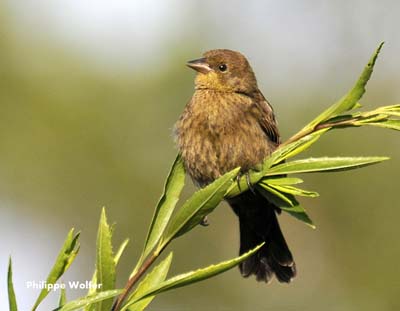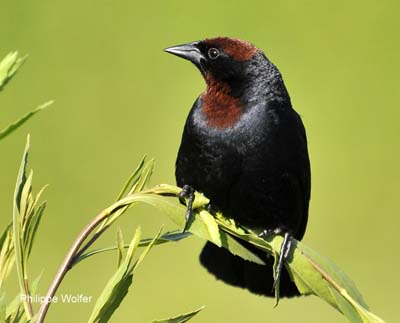
Chestnut-capped Blackbird
Chrysomus ruficapillus
Passeriforme Order – Icteridae Family
BIOMETRICS:
Length: 17-17,5 cm
DESCRIPTION:
Chestnut-capped Blackbird is a South American marsh blackbird.
Adult male in breeding plumage has glossy black plumage overall, except the chestnut throat and crown.
The strong bill is conical and black. Eyes are dark brown. Legs and feet are blackish.
In non-breeding plumage, the male is similar with olive-tipped back, breast and flank’s feathers.
Female lays 3 pale blue eggs spotted dark. Incubation lasts about 10 days. Young fledge between 10 and 13 days after hatching. Female feeds and care them almost alone.
The Chestnut-capped Blackbird’s nest is often parasitized by the Shiny Cowbird.
DIET:
Chestnut-capped Blackbird feeds mainly on insects and seeds, but it also consumes fruits.
PROTECTION / THREATS / STATUS:
Chestnut-capped Blackbird is locally uncommon to abundant and the species is not threatened at this moment.
Fr : Carouge à calotte rousse
All : Braunkopfstärling
Esp: Turpial de Gorro Castaño
Ital: Ittero capocastano
Nd: Bruinkaptroepiaal
Port: Garibaldi
Photographers:
Philippe et Aline Wolfer
GALERIE
Text by Nicole Bouglouan
Sources:
NEW WORLD BLACKBIRDS – THE ICTERIDS by Alvaro Jaramillo and Peter Burke – Helm - ISBN : 0713643331
BirdLife International (BirdLife International)
Wikipedia (Wikipedia, The Free Encyclopedia)
XENO-CANTO AMERICA – Birds sounds from the Americas

Female is different with olive-brown face and upperparts. The darker feather centres give streaked effect. Wings are brown with buffy-edged coverts, tertials and flight feathers. Tail is darker, blackish-brown.
On the underparts, throat is warm buff, turning greyer towards the back.
The bill is blackish with grey base. Eyes are dark brown. Legs and feet are black.
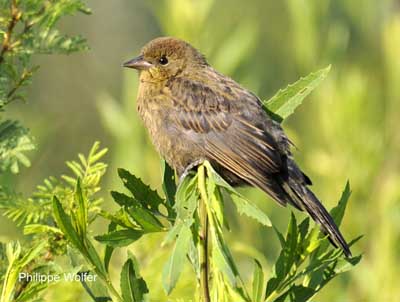
Juvenile resembles female but paler, with buffy-yellow face, breast and back. It has more streaked plumage on head and back. The wings show a pale panel with widely edged feathers.
We can find two subspecies:
C.r. ruficapillus occurs in the southern parts of the range.
C.r. frontalis occurs in French Guiana and N and C Brazil. It has brighter chestnut patches, mainly on the crown.
VOICE: SOUNDS BY XENO-CANTO
Chestnut-capped Blackbird utters sharp “chee” and high-pitched “tip” or some variation. It sometimes utters a slow chatter “che-che-che…”.
The song is variable in length and pitch. We can hear a short high-pitched song “tic-tic-WHEE”. The longest song has long terminal screech descending in pitch. Usually, two soft notes precede the screech “teep teep…tcheeeeerrrrr”.
Chestnut-capped Blackbird also performs series of sweet whistles and trills.
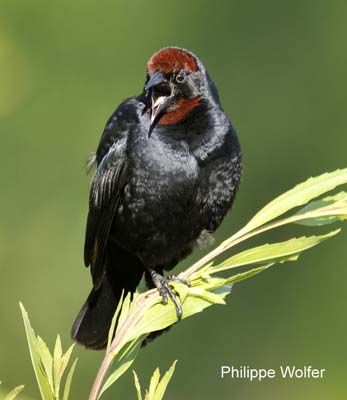
HABITAT:
Chestnut-capped Blackbird frequents several types of habitats such as marshes, roadside ditches, wet meadows and cultivated areas. It is often seen in ricefields.
This species breeds in lowland marshes and reedbeds.
Outside the breeding season, it often forages in fields away from water.
RANGE:
Chestnut-capped Blackbird is found in Argentina, Bolivia, Brazil, French Guiana, Paraguay and Uruguay.
The race “frontalis” occurs in French Guiana and N and C Brazil.
BEHAVIOUR:
Chestnut-capped Blackbird is gregarious all year round. Outside the breeding season, they gather in large flocks in cultivated areas, and mainly in ricefields. It feeds on insects, seeds and fruits.
They sometimes separate and may form single sex flocks in winter. They also may join other blackbirds’ flocks such as Shiny Cowbirds.
They roost in marshes all year round.
When the breeding season starts, the male performs courtship displays by singing from a stalk with fanned tail, fluffed out plumage and vibrating wings.
It also performs a short flight song during which it flies some metres high and descends by “parachuting” down to the aquatic vegetation with fully fanned tail.
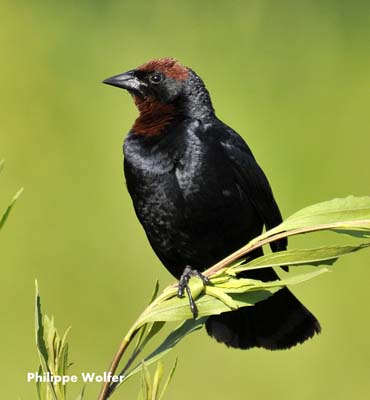
In the pre-copulatory displays, the male flutters its wings in front of the female.
Usually the male does not take part (or very little) to the nesting duties. It spends most of its time singing and displaying.
This species nests in colonies and the male is very aggressive towards other birds’ species such as Great Kiskadee and Yellow-winged Blackbird. It attacks and chases them away from the territory and the nest-site.
Chestnut-capped Blackbird is migratory, but its movements are poorly known. It performs erratic movements according to the water levels.
FLIGHT:
Chestnut-capped Blackbird performs bouncing flight.
REPRODUCTION:
Nesting season varies according to the range.
Chestnut-capped Blackbird nests in colonies. The female builds the cup-shaped nest anchored to the emergent vegetation, usually at one metre above the water surface. Nests often are within one metre to each other.
